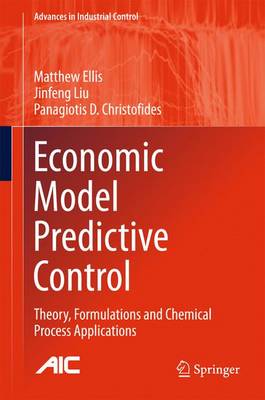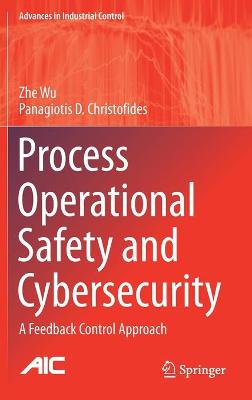Advances in Industrial Control
3 total works
Economic Model Predictive Control
by Matthew Ellis, Jinfeng Liu, and Panagiotis D Christofides
This book presents general methods for the design of economic model predictive control (EMPC) systems for broad classes of nonlinear systems that address key theoretical and practical considerations including recursive feasibility, closed-loop stability, closed-loop performance, and computational efficiency. Specifically, the book proposes:
- Lyapunov-based EMPC methods for nonlinear systems;
- two-tier EMPC architectures that are highly computationally efficient; and
- EMPC schemes handling explicitly uncertainty, time-varying cost functions, time-delays and multiple-time-scale dynamics.
The proposed methods employ a variety of tools ranging from nonlinear systems analysis, through Lyapunov-based control techniques to nonlinear dynamic optimization. The applicability and performance of the proposed methods are demonstrated through a number of chemical process examples.
The book presents state-of-the-art methods for the design of economic model predictive control systems for chemical processes.In addition to being mathematically rigorous, these methods accommodate key practical issues, for example, direct optimization of process economics, time-varying economic cost functions and computational efficiency. Numerous comments and remarks providing fundamental understanding of the merging of process economics and feedback control into a single framework are included. A control engineer can easily tailor the many detailed examples of industrial relevance given within the text to a specific application.
The authors present a rich collection of new research topics and references to significant recent work making Economic Model Predictive Control an important source of information and inspiration for academics and graduate students researching the area and for process engineers interested in applying its ideas.
Networked and Distributed Predictive Control
by Panagiotis D Christofides, Jinfeng Liu, and David Munoz de la Pena
Process Operational Safety and Cybersecurity
by Zhe Wu and Panagiotis D Christofides
This book is focused on the development of rigorous, yet practical, methods for the design of advanced process control systems to improve process operational safety and cybersecurity for a wide range of nonlinear process systems.
Process Operational Safety and Cybersecurity develops designs for novel model predictive control systems accounting for operational safety considerations, presents theoretical analysis on recursive feasibility and simultaneous closed-loop stability and safety, and discusses practical considerations including data-driven modeling of nonlinear processes, characterization of closed-loop stability regions and computational efficiency. The text then shifts focus to the design of integrated detection and model predictive control systems which improve process cybersecurity by efficiently detecting and mitigating the impact of intelligent cyber-attacks.
The book explores several key areas relating to operational safety and cybersecurity including:
- machine-learning-based modeling of nonlinear dynamical systems for model predictive control;
- a framework for detection and resilient control of sensor cyber-attacks for nonlinear systems;
- insight into theoretical and practical issues associated with the design of control systems for process operational safety and cybersecurity; and
- a number of numerical simulations of chemical process examples and Aspen simulations of large-scale chemical process networks of industrial relevance.
A basic knowledge of nonlinear system analysis, Lyapunov stability techniques, dynamic optimization, and machine-learning techniques will help readers to understand the methodologies proposed. The book is a valuable resource for academic researchers and graduate students pursuing research in this area as well as for process control engineers.
Advances in Industrial Control reports and encourages the transfer of technology in control engineering. The rapid development of control technology has an impact on all areas of the control discipline. The series offers an opportunity for researchers to present an extended exposition of new work in all aspects of industrial control.


